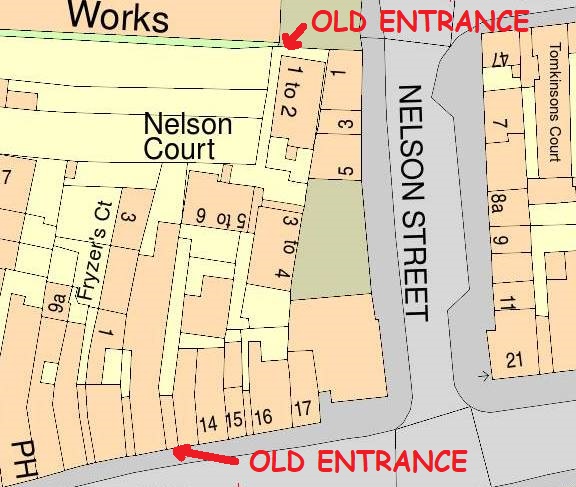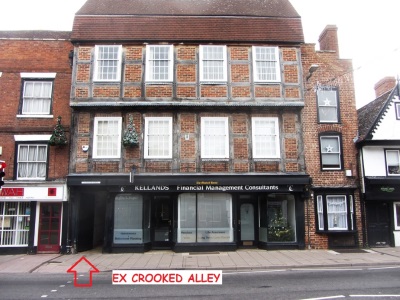Crooked Alley
As well as houses, there was industry. Mr Holland had a hat manufactory and Mr Davies had a stocking-frame-smith’s workshop. There was also a retail coal-yard and in 1881 Edward Sage applied for a licence to open a slaughterhouse.
In 1875, long after Nelson Street opened, John Potter and William Knight, being owners of nearly all the property in Crooked Alley made an application for it to be stopped up, so ending its role as a public highway and right of way. Despite some objection, the order was granted. Crooked Alley became Alexandra Court (from Barton Street) and Alexandra Place (from Oldbury Road). Alexandra is a departure from normal naming practice. It seems probable that it was named for Princess Alexandra of Denmark, who had married Edward Prince of Wales (later Edward VII) in 1863. Locally, though, people stuck doggedly to Crooked Alley. Even the census continued to use the old name.
to Expand
Crooked Alley is long gone, but was once a main thoroughfare between Barton Street and Oldbury Road. This was in the days, two hundred years ago, when there was no road where Nelson Street now is; just a series of alleys.
Crooked Alley is named for its layout, not its character. It was an alley which had changed route, for long-forgotten reasons, and had two right-angled bends. Presumably, two alleys had been joined and modified. It was unique in Tewkesbury. The entrances can still be seen. The Barton Street entrance is a doorway on the left of the Mustard House (Kellands Financial Management) with a sign, ‘13a Barton Street’, above it. The Oldbury entrance was through the entrance now called ‘Nelson’s Court’ behind Ginger’s hairdressers.
The alley seems to have been typically overcrowded and insanitary. There were regular concerns expressed about the condition of the drainage and the state of the well. Crooked Alley was hit particularly hard in the Cholera outbreak of 1849. Six people, from four households, died in August: Samuel Hawkins, 54, Stocking maker; Ann Hawkins, 49, washerwoman; James Farmer, 40, Rope-maker; Sarah Weaver, 50, Shoe-binder; Ann Weaver, 6, Shoe-binder; Elizabeth Edgewick, 65, Fortune Teller. Though improvements were made, there were continuing problems with drainage and water, and in 1914 it was reported that the nuisance of having insufficient WCs had at last been resolved.

The stopping-up was intended to allow Potter and Knight to make ‘great alterations and improvements’. In Alexandra Court, most of the property seems to have been demolished to create a garden, but Alexandra Place remained unimproved. By 1918, there were problems with dereliction and a series of attempts to get improvements made. Paving was a particular problem, and having had no success in persuading the property owners, by now Mrs Pullin and Mr Holbrook, to carry out the work, the Council took the unusual step of using the Private Street Works Act to do it themselves and recharge the owners. It must have been very bad!
There were the all too familiar tragedies during the First World War. The Collins family were more involved than most. Their son, Private F J Collins, 2nd Gloucesters, was killed by shrapnel in February 1915. In March 1917, son-in-law Corporal Jack Matty, 1st Gloucesters was killed in action. Son Jesse fared better in the Royal navy, though. He survived the battle of Jutland unscathed.
The alley just faded away. The final demise came after Nelson Street was widened thirty years ago, with property in the vicinity being emptied long before that. In recent years, the area of Alexandra Place has been redeveloped to create a modern version of a court, now named Nelson Court.



Comments